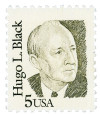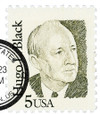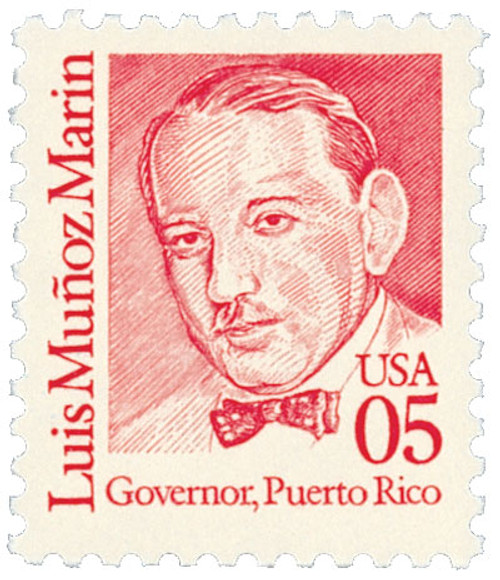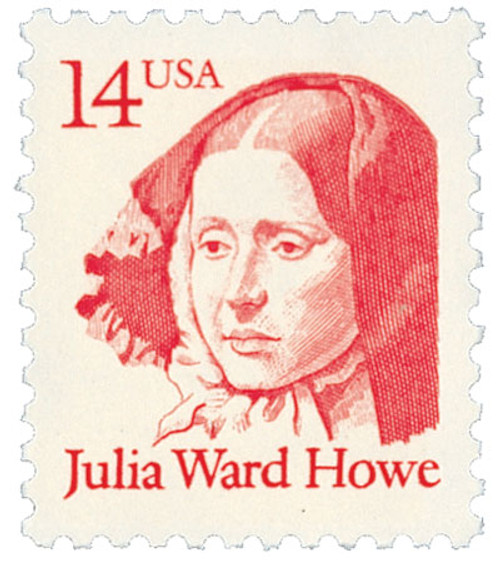
# 2172 - 1986 5c Great Americans: Hugo L. Black
U.S. #2172
1986 5¢ Hugo L. Black
Great Americans
- 28th stamp in Great Americans Series
- Seventh US stamp to honor a Supreme Court justice
- First Supreme Court Justice honored in Great Americans Series
Stamp Category: Definitive
Series: Great Americans
Value: 5¢, used for make-up postage
First Day of Issue: February 27, 1986
First Day City: Washington, D.C.
Quantity Issued: 57,210,000
Printed by: Bureau of Engraving and Printing
Printing Method: Engraved
Format: Panes of 100 in sheets of 800
Perforations: 11
Color: Dark olive green
Why the stamp was issued: This 5¢ stamp is what the USPS calls “change maker” postage. These stamps with denominations of 1¢ through 6¢ are produced to make up the wide variety of rates for third-class parcel post, which has many combinations of charges for weight and distance. These stamps were also useful when first-class rates went up, before the USPS could release stamps at the new rate.
About the stamp design: Chris Calle created the artwork for this stamp, based on an original photo of Hugo Black. Interestingly, this stamp replaced the 1983 5¢ Pearl Buck stamp, which was designed by Paul Calle, Chris’ father.
First Day City: The First Day ceremony for this stamp was held in a small conference room within the Supreme Court building. The ceremony was closed to the public with only a select number of invitees, including Chief Justice Warren Burger.
About the Great Americans Series: The Great Americans Series was created to replace the Americana Series. The new series would be characterized by a standard definitive size, simple design, and monochromatic colors.
This simple design included a portrait, “USA,” the denomination, the person’s name, and in some cases, their occupation or reason for recognition. The first stamp in the new series was issued on December 27, 1980. It honored Sequoyah and fulfilled the new international postcard rate that would go into effect in January 1981.
The Great Americans Series would honor a wider range of people than the previous Prominent Americans and Liberty Series. While those series mainly honored presidents and politicians, the Great Americans Series featured people from many fields and ethnicities. They were individuals who were leaders in education, the military, literature, the arts, and human and civil rights. Plus, while the previous series only honored a few women, the Great Americans featured 15 women. This was also the first definitive series to honor Native Americans, with five stamps.
The Bureau of Engraving and Printing (BEP) produced most of the stamps, but private firms printed some. Several stamps saw multiple printings. The result was many different varieties, with tagging being the key to understanding them. Though there were also differences in perforations, gum, paper, and ink color.
The final stamp in the series was issued on July 17, 1999, honoring Justin S. Morrill. Spanning 20 years, the Great Americans was the longest-running US definitive series. It was also the largest series of face-different stamps, with a total of 63.
Click here for all the individual stamps and click here for the complete series.
History the stamp represents: Hugo Lafayette Black was born on February 27, 1886, in Harlan, Alabama. He’s the fifth longest-serving US Supreme Court justice and historians recognize him as second only to John Marshall in his impact on constitutional interpretation.
The youngest of eight children, Black’s family moved to Ashland in 1890. He attended college there and then earned a degree from the University of Alabama Law School in 1906. After being admitted to the bar and practicing in Ashland, he moved to Birmingham where he started a successful law practice known for dealing with labor laws and personal injury cases.
In 1911, Black briefly served as a police court judge and later served four years as the Jefferson County Prosecuting Attorney. Black left his law practice during World War I to join the Army. He reached the rank of captain in the 81st Field Artillery, but the war ended before he could be sent overseas. Black returned to his law practice after the war then won a US Senate seat in 1926. He became known for his keen investigative skills and in 1934 chaired the committee that investigated an airmail contract scandal. Black also investigated lobbying practices and pushed for legislation requiring them to register their names and salaries.
In 1937, Black proposed the Black-Connery Bill, which would set a national minimum wage and maximum number of workweek hours at 30. The bill was rejected at first, but was amended to 44 hours and passed after Black left the Senate in 1938. During his time in the Senate, Black spoke out about his beliefs in the power of the Constitution. He supported Franklin Roosevelt’s New Deal policies and criticized the Supreme Court for overturning legislation that had been passed by significant majorities in Congress.
In 1937, Supreme Court Justice Willis Van Devanter retired, and Roosevelt nominated Black as his replacement. For the first time since 1853, the Senate didn’t confirm him immediately, rather they sent the nomination to the Judiciary Committee. He was eventually confirmed, but shortly after it became national news that he had been a member of the Ku Klux Klan in the early 1920s. Black stated that he had been a member, but that he left it and “completely discontinued any association with the organization.” He later admitted that joining had been a mistake.
There was widespread outrage at first, but Black’s friendship with Walter Francis White, executive secretary of the NAACP, helped assuage concerns. In 1940, he delivered a decision which freed four black men who had confessed to crimes after being tortured. This decision was called “far and away the most brilliant, sweeping application of the 14th Amendment to human rights that has come before the Supreme Court.” This helped to calm concerns over his past.
As a Supreme Court Justice, Black believed in judicial restraint. He felt the legislature should dictate laws and the court should limit its involvement. He was also noted for protecting the right of free speech guaranteed in the First Amendment to the US Constitution. Black served on the Supreme Court for 34 years. He was the fifth-longest serving US Supreme Court Justice and the senior (longest serving) justice for 25 years. Experts state he was second only to John Marshall in his impact on the Constitution.
Black retired on September 17, 1971, suffered a stroke two days later, and died on September 25. During his life, Black appeared on the cover of Time magazine twice. After his death, the US District Court in Birmingham, Alabama, was named in his honor.
U.S. #2172
1986 5¢ Hugo L. Black
Great Americans
- 28th stamp in Great Americans Series
- Seventh US stamp to honor a Supreme Court justice
- First Supreme Court Justice honored in Great Americans Series
Stamp Category: Definitive
Series: Great Americans
Value: 5¢, used for make-up postage
First Day of Issue: February 27, 1986
First Day City: Washington, D.C.
Quantity Issued: 57,210,000
Printed by: Bureau of Engraving and Printing
Printing Method: Engraved
Format: Panes of 100 in sheets of 800
Perforations: 11
Color: Dark olive green
Why the stamp was issued: This 5¢ stamp is what the USPS calls “change maker” postage. These stamps with denominations of 1¢ through 6¢ are produced to make up the wide variety of rates for third-class parcel post, which has many combinations of charges for weight and distance. These stamps were also useful when first-class rates went up, before the USPS could release stamps at the new rate.
About the stamp design: Chris Calle created the artwork for this stamp, based on an original photo of Hugo Black. Interestingly, this stamp replaced the 1983 5¢ Pearl Buck stamp, which was designed by Paul Calle, Chris’ father.
First Day City: The First Day ceremony for this stamp was held in a small conference room within the Supreme Court building. The ceremony was closed to the public with only a select number of invitees, including Chief Justice Warren Burger.
About the Great Americans Series: The Great Americans Series was created to replace the Americana Series. The new series would be characterized by a standard definitive size, simple design, and monochromatic colors.
This simple design included a portrait, “USA,” the denomination, the person’s name, and in some cases, their occupation or reason for recognition. The first stamp in the new series was issued on December 27, 1980. It honored Sequoyah and fulfilled the new international postcard rate that would go into effect in January 1981.
The Great Americans Series would honor a wider range of people than the previous Prominent Americans and Liberty Series. While those series mainly honored presidents and politicians, the Great Americans Series featured people from many fields and ethnicities. They were individuals who were leaders in education, the military, literature, the arts, and human and civil rights. Plus, while the previous series only honored a few women, the Great Americans featured 15 women. This was also the first definitive series to honor Native Americans, with five stamps.
The Bureau of Engraving and Printing (BEP) produced most of the stamps, but private firms printed some. Several stamps saw multiple printings. The result was many different varieties, with tagging being the key to understanding them. Though there were also differences in perforations, gum, paper, and ink color.
The final stamp in the series was issued on July 17, 1999, honoring Justin S. Morrill. Spanning 20 years, the Great Americans was the longest-running US definitive series. It was also the largest series of face-different stamps, with a total of 63.
Click here for all the individual stamps and click here for the complete series.
History the stamp represents: Hugo Lafayette Black was born on February 27, 1886, in Harlan, Alabama. He’s the fifth longest-serving US Supreme Court justice and historians recognize him as second only to John Marshall in his impact on constitutional interpretation.
The youngest of eight children, Black’s family moved to Ashland in 1890. He attended college there and then earned a degree from the University of Alabama Law School in 1906. After being admitted to the bar and practicing in Ashland, he moved to Birmingham where he started a successful law practice known for dealing with labor laws and personal injury cases.
In 1911, Black briefly served as a police court judge and later served four years as the Jefferson County Prosecuting Attorney. Black left his law practice during World War I to join the Army. He reached the rank of captain in the 81st Field Artillery, but the war ended before he could be sent overseas. Black returned to his law practice after the war then won a US Senate seat in 1926. He became known for his keen investigative skills and in 1934 chaired the committee that investigated an airmail contract scandal. Black also investigated lobbying practices and pushed for legislation requiring them to register their names and salaries.
In 1937, Black proposed the Black-Connery Bill, which would set a national minimum wage and maximum number of workweek hours at 30. The bill was rejected at first, but was amended to 44 hours and passed after Black left the Senate in 1938. During his time in the Senate, Black spoke out about his beliefs in the power of the Constitution. He supported Franklin Roosevelt’s New Deal policies and criticized the Supreme Court for overturning legislation that had been passed by significant majorities in Congress.
In 1937, Supreme Court Justice Willis Van Devanter retired, and Roosevelt nominated Black as his replacement. For the first time since 1853, the Senate didn’t confirm him immediately, rather they sent the nomination to the Judiciary Committee. He was eventually confirmed, but shortly after it became national news that he had been a member of the Ku Klux Klan in the early 1920s. Black stated that he had been a member, but that he left it and “completely discontinued any association with the organization.” He later admitted that joining had been a mistake.
There was widespread outrage at first, but Black’s friendship with Walter Francis White, executive secretary of the NAACP, helped assuage concerns. In 1940, he delivered a decision which freed four black men who had confessed to crimes after being tortured. This decision was called “far and away the most brilliant, sweeping application of the 14th Amendment to human rights that has come before the Supreme Court.” This helped to calm concerns over his past.
As a Supreme Court Justice, Black believed in judicial restraint. He felt the legislature should dictate laws and the court should limit its involvement. He was also noted for protecting the right of free speech guaranteed in the First Amendment to the US Constitution. Black served on the Supreme Court for 34 years. He was the fifth-longest serving US Supreme Court Justice and the senior (longest serving) justice for 25 years. Experts state he was second only to John Marshall in his impact on the Constitution.
Black retired on September 17, 1971, suffered a stroke two days later, and died on September 25. During his life, Black appeared on the cover of Time magazine twice. After his death, the US District Court in Birmingham, Alabama, was named in his honor.






















